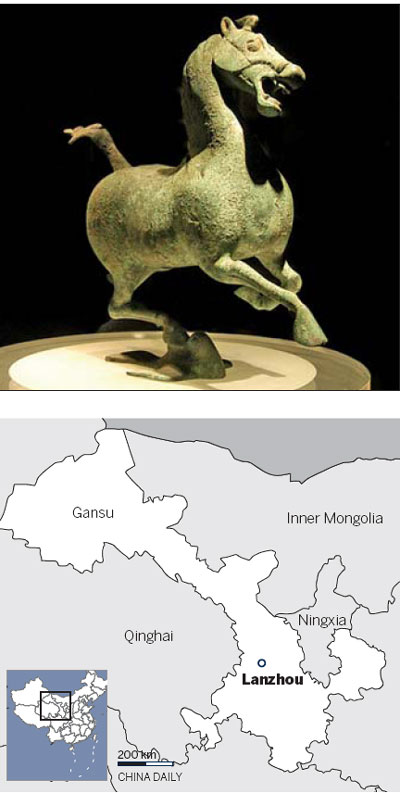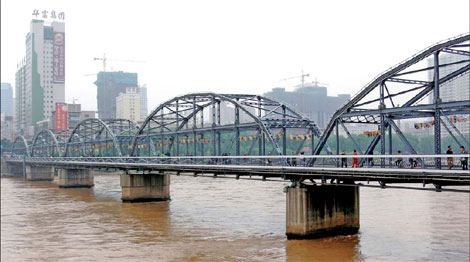Crossing point
Updated: 2011-12-30 07:43
(China Daily)
|
||||||||
|
Above: Zhongshan Iron Bridge in Lanzhou is said to be the first bridge built across the Yellow River. Below: The bronze horse in Gansu provincial museum. [Photos provided to China Daily] |

Historic lanzhou, a city in the northwest, acted as a bridge between the east and west
As a strategic point along the ancient Silk Road, it witnessed some of the earliest trade and cultural exchanges between imperial China and the Roman Empire. Fast forward to the modern age and Lanzhou still holds a commanding presence as a key transport and communications link between the country's northwest and east.
Lanzhou, the provincial capital of Gansu, is surrounded by mountain ranges in the north and south, and is located on the upper reaches of the Yellow River.
Apart from its importance as a garrison and transport hub, Lanzhou was also known as "Gold City" because of the goldmines in the area when the city was built. The city also became a center of Buddhism between the 5th and the 11th centuries. It acquired its present name during the Qing Dynasty (1644-1911).
Lanzhou's climate is dry, with sunshine all year round, and vide variations in temperature during the day and night. It experiences long and cold winters with little rain and snow. Spring is also short with huge temperature swings. Summer, while similarly short, is only mildly hot. Temperatures drop quickly as autumn approaches. So the best time to visit this city is in late spring and early summer.
With its fertile soil, dry climate and abundant sunshine backed by tried and tested irrigation systems, Lanzhou is ideal for growing sweet fruit, particularly melons. It is also well known for black watermelon seeds, pears, honey peaches, lilies, hotbed chives and roses.
Here are three attractions:
1. Gansu provincial museum
The exhibits include a bronze horse poised to take flight, with one of its hooves resting lightly on a swallow with wings outstretched. The horse was excavated from an Eastern Han Dynasty (AD 25-220) tomb discovered in Gansu.
The exhibition hall of relics offers about 1,500 items, including painted pottery bowls, vessels and ancient agricultural tools that were excavated from the Silk Road of the Western Han Dynasty (206 BC-AD 24) and Tang Dynasty (AD 618-907).
The pottery patterns include detailed birds, frogs and flowers. Among them, ceramic vessels of the Majiayao culture excavated from the Yellow River Valley are rated highly because geometric motifs like parallel lines, circles, crosses and spirals were first used.
The prehistoric life hall includes a fossil of the Yellow River ancient elephant, which is touted as the largest and best-preserved in the world.
2. Zhangye Road
Zhangye Road is to Lanzhou what Oxford Street is to London or the Champs-Elysees is to Paris. This shopping thoroughfare has a long history filled with rich cultural heritage, becoming the main avenue of an ancient walled city during the Song Dynasty (960-1279).
During the Ming Dynasty (1368-1644), the road was the only east to west avenue, with many examples of religious architecture, including the Town God's Temple, Dongyue Taoist Temple, Donghua Taoist Temple and Zhuangye Buddhist Temple.
Zhangye Road now boasts numerous stores and restaurants, where tourists can enjoy local delights. Lanzhou's beef noodle dish, which dates back more than a century, is considered China's best noodle dish for its clear broth, tender and savory beef, fine noodles and equally delectable colors of the main ingredients and its garnishes.
Deep fried cakes are another famous local dish. Rock and powdered sugar, treated roses, walnuts, sesame seeds and other ingredients provide the filling for dough shaped into small round cakes.
At the west end of the road, tourists can take in the high and slender towers of the largest mosque in Lanzhou, Xiguan Mosque, which is also known as West Cross Mosque.
3. White Pagoda Hill Park
Legend has it that the White Pagoda was built in honor of a highly respected Tibetan lama who died of an illness in Lanzhou on his way to meet Genghis Khan.
The present pagoda was built during the Ming Dynasty and later expanded in the Qing Dynasty.
The 17-meter-high, seven-story pagoda is a solid brick structure. The old temple boasted three treasures - an elephant skin drum, bronze bell and redbud trees. The trees were replanted in modern times and the other two treasures are still housed in the pagoda. After many years of successful reforestation, the surrounding park has also taken on a new look.
An ancient bridge nearby popularly known as Zhongshan Iron Bridge or the Yellow River Iron Bridge, is located at the foot of White Pagoda Hill. First built near the end of the Qing Dynasty, it is said to be the first bridge built across the Yellow River.
China Daily












